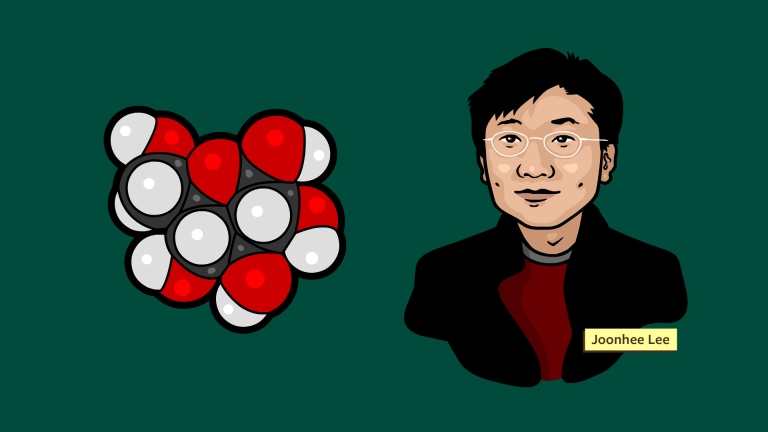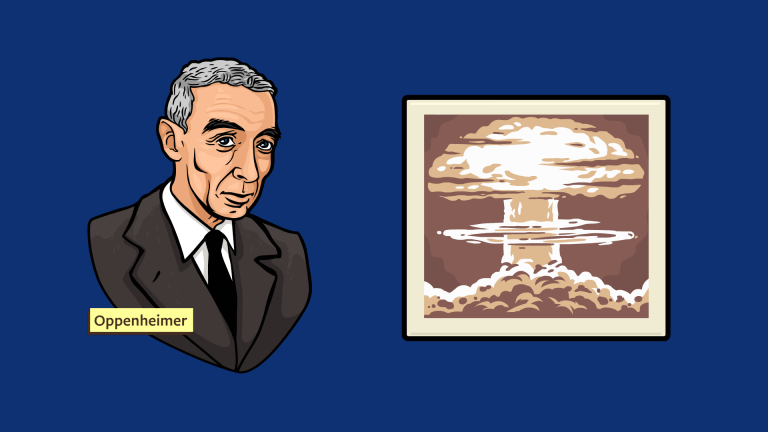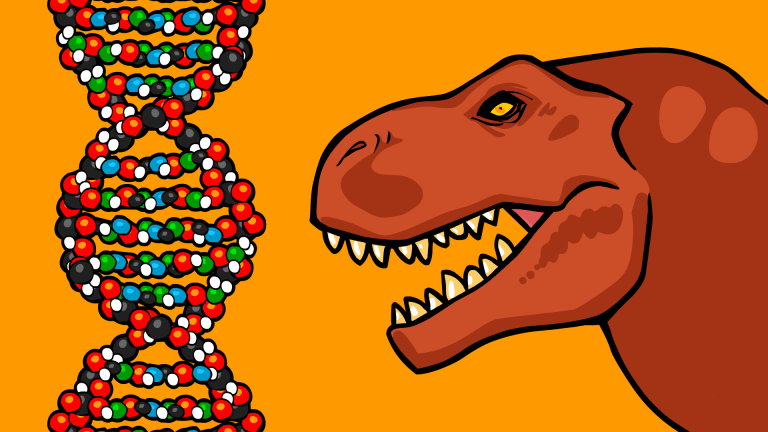Overview
Atoms are the fundamental subjects studied in chemistry. Here you will learn the history of their discovery, starting with the philosophical concept of atoms in ancient India and Greece. You will learn of experiments conducted by Islamic and European scientists which eventually led to the formal description of atoms in 1808. Finally, you will learn of advancements in microscopes, allowing us to actually see atoms with our own eyes.
This video was funded by the CaSTL Research Center and comes with a video game called Bond Breaker. Aside from being almost addictive to play, it’s extremely useful. Playing will give you an intuitive understanding of how atoms (and their subatomic particles) interact to form chemical bonds:
Explore Further
Stated Clearly animations about atoms and molecules:
PDF of John Dalton’s Original book on atomic theory:
A much more readable overview of Dalton’s book:
Scientific Paper by CaSTL researchers on how to “shrink” light for use in atomic resolution imaging:
For Teachers
The content of this video meets criteria in the following Disciplinary Core Ideas defined by Next Generation Science Standards. Use our videos to supplement classroom curriculum.
Contributors
Our videos benefit from guidance and advice provided by experts in science and education. This animation is the result of collaboration between the following scientists, educators, and our team of creatives.
Advisors
- Ara Apkarian, PhD
- Danielle Watt, PhD
- David O. Conover, PhD
- Eric Potma, PhD
- Eric T. Parker, PhD
- Johana Revel, PhD
- Joonhee Lee, PhD
- Suhail Alhejji
- Tom Cochran
- Venkat Bommisetty, PhD
- Wilson Ho, PhD
Team
- Jon Perry
- Anthony Danzl
- Jordan Collver
- Tyler Proctor
Corrections
In this video we state that Jabir ibn Hayyan was Arabian, but there is uncertainty about this among historians. He may have been Persian. Like many influential people of his time, his story is almost mythical, with multiple origins being found in historical writings.
Also, he never used a Bunsen burner (which is what we erroneously drew him using), which wasn’t invented until 1856. Jabir likely burnt wood or other solid fuels to heat his reactions.
Transcript
Atoms are the fundamental building blocks of chemistry. Just like baked goods are made of a collection of different types of ingredients, matter itself, is made of a collection of different types of atoms.
Scientists have discovered 118 kinds of atoms, which we call elements. They’re laid out on a chart called the Periodic Table.
All things from the screen this video is displayed on, to the eyeballs with which you’re watching it, are made of atoms but a single atom is so small, it is impossible to see with the naked eye.
So there you have it. A random voice from a video you found on the internet claims that everything is made of invisibly small atoms. You may now blindly accept this as fact and happily move on with your day, right? No? Now you’re extra curious? You want to know for yourself exactly why it is that scientists think that atoms exist?
To find out we must travel back in time to ancient Greece: Meet Democritus, the man that many historians credit for first clearly proposing the idea of an atom.
In his day It was thought by some that if you were to chop up a piece of matter, an apple for instance, you could just keep chopping forever and ever, there was no end to smallness.
For reasons not fully agreed upon by historians, this concept did not sit well with Democritus. Instead he insisted that at some point you would reach particles so small and so indestructible they could not be divided any further. He called them “Atomos” or atoms, which means “uncuttable”.
Democritus didn’t actually have any evidence to back his claim and because of that, many people rejected his idea. After all, that which can be asserted without evidence can be dismissed without evidence.
Let’s fast forward several hundred years and hop over to the Arabic world. You probably know that salt can be extracted from seawater by simply boiling it dry. People have been doing this forever but Alchemist Jabir ibn Hayyan and those that followed his work, took the science extraction to a whole new level.
Through careful experimentation they developed complex processes of filtration, boiling, vapor collection and cooling. They found that crude starting materials could be divided into multiple incredibly pure substances. Pure meaning they appeared consistent all the way through unlike the complex mixtures of matter we often find in nature.
In the 1700s, a French husband and wife scientific duo (Marie-Anne Paulze and Antoine Lavoisier) studied and built upon the work of their Arabic predecessors. They found that certain pure substances could be broken down even further through chemical reactions. Water, for example, can be split into into two pure gases: hydrogen and oxygen.
No matter how hard they tried, however, they could not reduce oxygen or hydrogen into simpler gases. They concluded that the gases must be elements – foundational substances that cannot be created by mixing other chemicals together, and cannot be broken down any further.
With this concept in mind, scientists everywhere begin searching for and listing as many elements as they could, eventually discovering all 118 listed on the modern periodic table. Some, such as oxygen and hydrogen, are gases at room temperature. Others are solid, such as elemental carbon and gold. Other’s still are liquid at room temperature – mercury and bromine.
It was also found that under the right conditions (pressure and temperature) certain elements will react with each other upon mixing, to form new substances with new properties. These are called compounds.
The elements oxygen and iron can react to form a brown powder. Oxygen and mercury react to form a toxic orange powder. Oxygen and hydrogen react to form a clear refreshing liquid, and so on.
Though the steps may be complicated, all of these reactions can be reversed, elements can be separated again, and the amount of each element we get back after separation, is always exactly equal to the amount that had reacted to the form the compound in the first place.
Brilliant!
Elements are real and they appear to be essentially indestructible but what are they made of? If you zoom in on one, a chunk of pure gold example, can you just keep zooming in for ever and ever, seeing nothing but pure good for infinity?
In the early 1800s, a school teacher from England named John Dalton grew fascinated with chemistry. Along with conducting several experiments of his own, he read about every experiment he possibly could paying special attention to the quantities of each element used up in every chemical reaction. In these numbers he was surprised to find a pattern. When 2 elements can react to form multiple types compounds, they always do so in small, whole number ratios. The most logical explanation for this strange pattern is that the elements are made of tiny particles – atoms!
He didn’t know exactly how small an atom was but numbers suggested that atoms of a single element were all nearly identical in size to each other but different in size to the atoms found in other elements.
In 1808 he wrote a 560 page book that briefly mentioned his discovery, and it even came with pictures.
While scientists weren’t fully convinced that atoms were real, they found the concept of atoms extremely useful. The idea of atoms helped them make predictions and perform cleaner chemical reactions.
In 1905, Albert Einstein… well, he was younger than that in 1905… Albert Einstein proposed an experiment and produced an equation that could be used, not only to confirm the existence of atoms, but to to determine exactly how big they are.
A few years later, Jean Perrin used Einstein’s concept to actually do the experiments, confirming beyond reasonable doubt (at least to other physicists and mathematicians) that atoms do exist!
If you happen to love math and posses an in depth grasp of physics, great! You can turn off this video now and read Perrin’s paper. For the rest of us, however, seeing is believing.
Individual atoms are too small to be seen with normal light, because of this, they cannot be seen with a normal microscope.
In the 1980s, a group of engineers lead by Gerd Binnig and Heinrich Rohrer began working on what they called the Scanning Tunnelling Microscope. A microscope they hoped would let us take undistorted images of many different types of atoms.
This is an actual scan of silicon atoms forming the surface of a crystal. The colors here are artificial, assigned to different data points received during the scan, but this is real data showing the actual pattern of silicon atoms arranged in the sample.
Later work by Dr Wilson Ho, improved the technique and cleaned up the presentation of data. While “feeling” the atoms does give us some good information, researchers still wanted more.
A group lead by Dr Ara Apkarian of the National Science Foundation’s CaSTL research center, discovered a way to use actual light to see atoms.
In the past, this was thought to be impossible because the wavelength of light is so much larger than an atom, but by shooting light at the tip of a probe in a modified scanning tunneling microscope, they were able to essentially shrink the light’s wavelength, and get it to scatter off the sample onto a detection screen.
By moving the sample bit by bit, hitting it with light again each time, they were able to piece together this image of a single nitrogen atom. Each pixel, representing an individual data point from the scan. If we smooth it out, sharpen the edges, and change their chosen color scheme, it is shocking to find how close John Dalton’s old drawings actually were to reality.
Our species has finally done it. Over 2000 after Democritus first proposed the idea of an atom, we have now received direct, visual confirmation. Atoms exist!
So what is an atom? Atoms are the fundamental building blocks of chemistry.
How do we know they exist? Through chemical reactions we can witness their effects. Through mathematical equations combined with indirect observations, we can calculate their various sizes. And finally, with the aid of new technologies such as the Scanning Tunnelling Microscope, atoms can now be seen.





